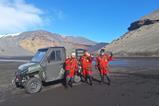We ignore the under-studied oceans at our peril, yet they could be key to solving the biggest problems we will face in the years to come.
Earth seems like an odd pick for the name of our planet. When seen from space, Earth’s massive oceans are definitely its most striking feature. This comes as no surprise as 71% of our planet is covered in water, with 96.5% of it being in its oceans.
When analysed at the biological level, oceans are even more impressive. They are teeming with life, having an unparalleled diversity and abundance at a scale that is hard to grasp, particularly from a microbial perspective.

Estimates indicate that the number of bacteria in our oceans massively outnumber the number of stars in the Universe, yet we still know very little about them. So far, we have been able to study less than 1% of total microbial species of our planet so their true role, impact, and potential remains unassessed.
Ecological niches
Oceans are rich in very different ecological niches whose microbiology remains under-studied. Associated with oceans, we have different types of coastal regions, occurring at the interface between aquatic and terrestrial environments and in close proximity to humans.
Due to this, most such locations, including salt marshes, mangroves, and even human-made or natural salterns are threatened as they are facing increased challenges to their existence. Impacts from climate change, coastal erosion, pollution, or even construction pressure and other detrimental effects of human presence and activity are quickly disrupting these rich ecosystems. Sadly, many of these sites, particularly those in developing countries, will likely be gone before we are able to study their microbiology.
Oceans also include some of the most exotic and extreme environments on our planet, ranging from the boiling temperatures of hydrothermal vents to the crushing pressures of deep-sea trenches, or the challenging multiple extremes of deep-sea brine lakes.
New microbes
Microbial life has been able to adapt and thrive under all such conditions, and they are the sources of some of the most interesting new microbes, being linked with the discovery of several new higher-ranked taxa, and new insights into the origin and evolution of life.
Some notable examples of success stories include Haloquadratum walsbyi (abundant square-shaped archaea which eluded cultivation for several decades), Pelagibacter ubique (the most abundant organism on our planet and representing 25% of microbial plankton, it was previously overlooked), or the recent isolation of the first Asgard Archaea (result from a 12-year-long experiment, which is an epic testament of persistence).
There are clear benefits to exploring microbial diversity and communities present in our oceans, particularly when looking into threatened or remote and under-studied sites. Some, like me, might say that the joy of discovering exotic new microbes is a reward in itself and a vital tool to help us to better understand Life’s diversity, abundance, versatility, and resilience.
Sources of biomolecules
On the other side, we do have an important applied component coupled with the study and discovery of new microbes from these environments. The isolation and characterization of new microbial strains from such sites is essential fuel for the bioeconomy. They are essential sources of new enzymes and other biomolecules, and used in e.g., bio-catalysis, bioengineering, biofuel, and pharmaceuticals.
Microbes from our oceans will likely play a major role in addressing society’s biggest challenges: how to feed, fuel, and heal the world. The microbiology of our oceans is even linked to some less obvious sectors, namely space exploration (e.g., for microbial in situ resource utilisation) and even the search for life outside our planet.
No current discussion on the relevance of oceans would be complete without looking beyond our pale blue dot. We now know that Earth is not the only ocean world in our solar system, with significant evidence of massive liquid water oceans hidden beneath several icy moons and dwarf planets of the outer solar system.
Extraterrestrial oceans
Europa, with estimated water reserves that are two times larger than those of our planet, and Enceladus, with its striking hydrothermal plumes which project its water into space, are the two most popular examples.
There are still several unknowns about the exact physical-chemical conditions of these exooceans, but presence of such vast reserves of liquid water provides exciting new frontiers for the search of life outside our planet and a renewed impetus for the search and study of equivalent conditions on Earth and associated microbial inhabitants. Such studies are vital in bringing us closer to finally finding an answer to the biggest question that humanity has ever asked: Are we alone in the Universe?
Dr André Antunes of Macau University of Science and Technology is an AMI Global Ambassador for Asia and Oceania. He is an environmental microbiologist, who has devoted most of his research life to the study of microbial communities in marine and extreme environments. He is particularly interested in microbial biodiversity, changes in microbial community structure across environmental gradients, adaptations to extreme conditions and in cross-disciplinary research in the fields of geomicrobiology and astrobiology.










No comments yet